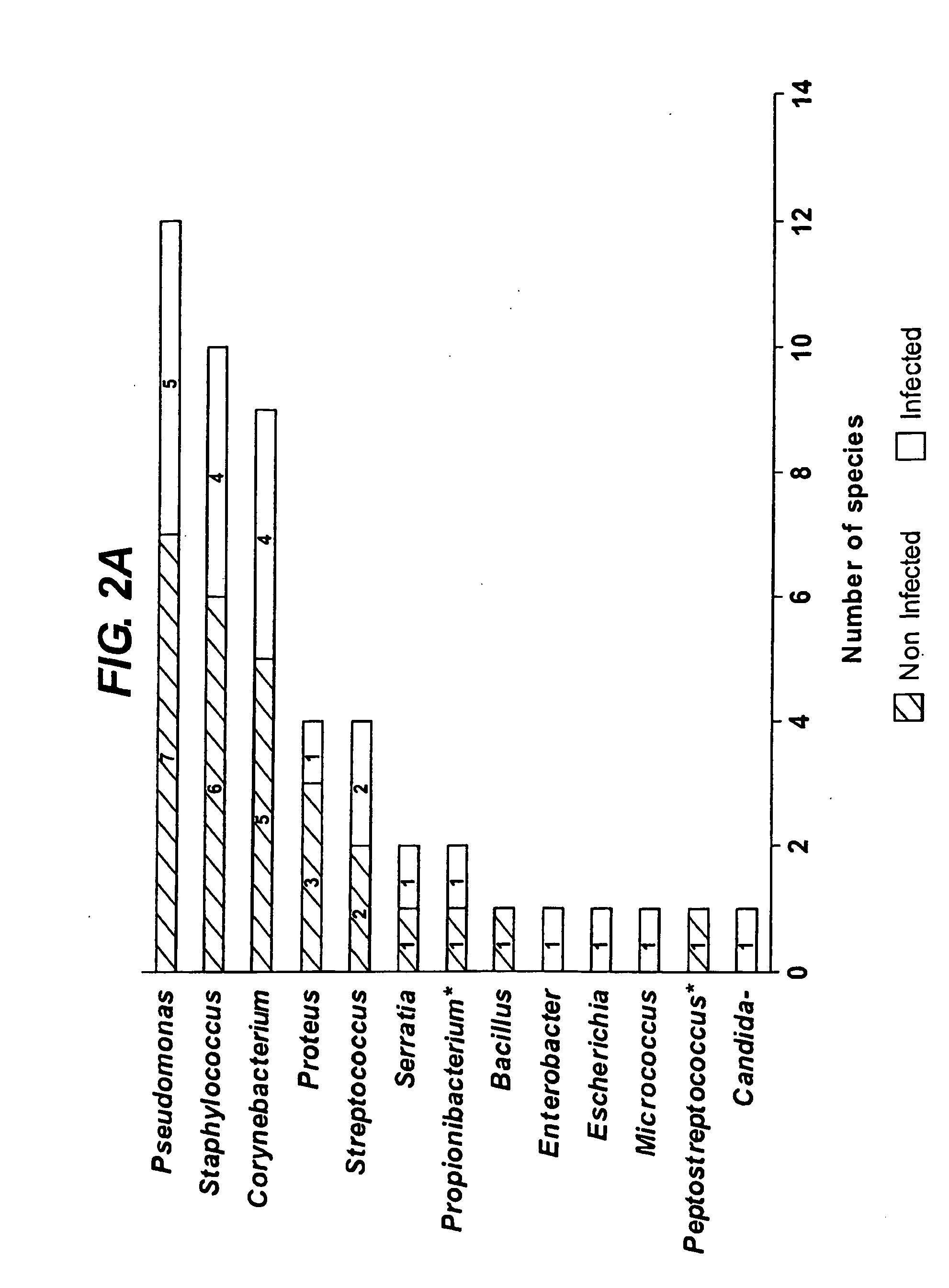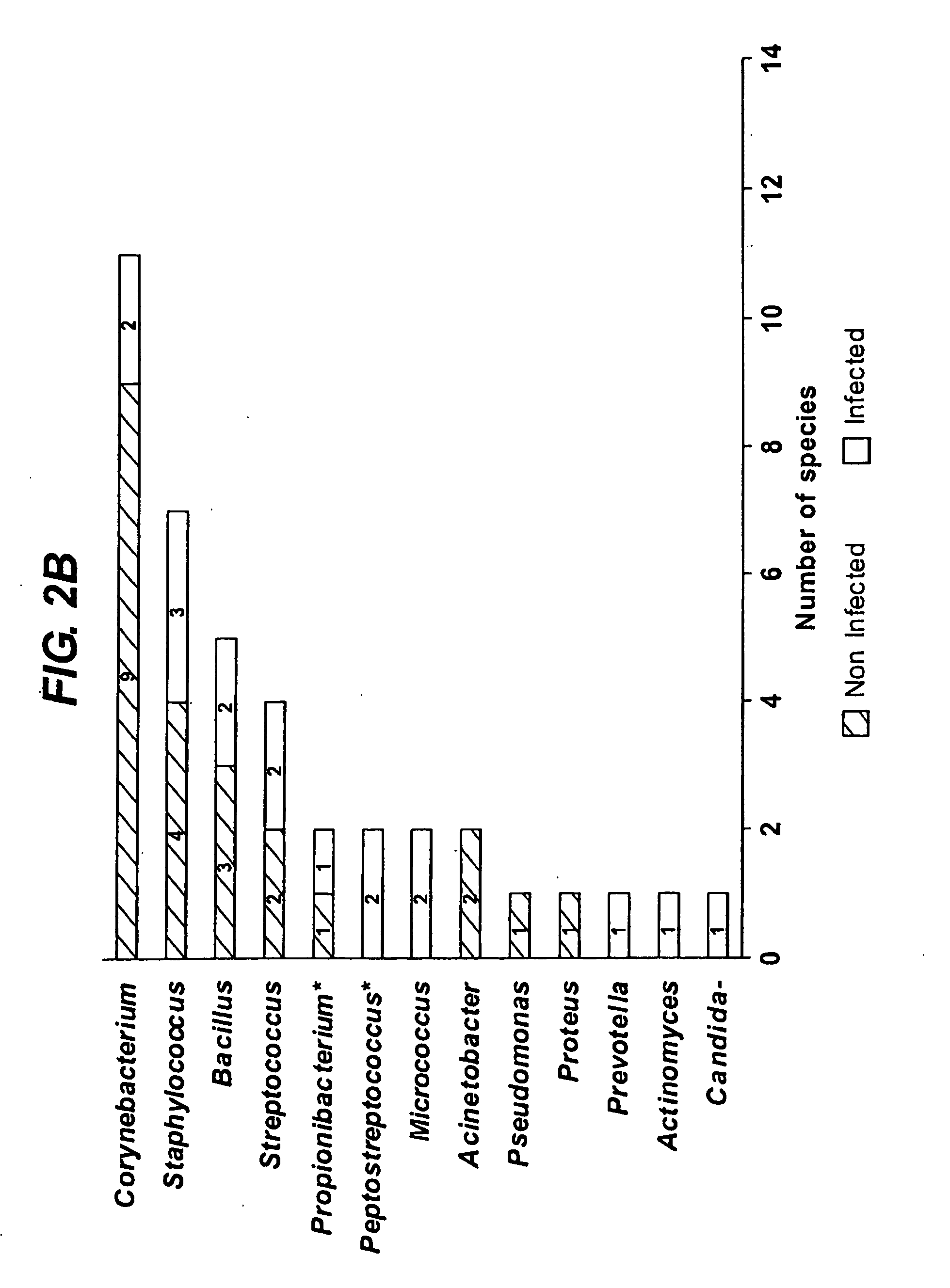Diagnostic markers of wound infection
a diagnostic marker and wound infection technology, applied in the field of monitoring patients, can solve the problems of poor correlation between clinical signs of infection and actual measured bioburden in the wounds that were studied, and cannot mount an efficient immune response to microbial contamination, and achieve the effect of low level of relevant cytokine and low cytokine level
- Summary
- Abstract
- Description
- Claims
- Application Information
AI Technical Summary
Benefits of technology
Problems solved by technology
Method used
Image
Examples
reference example 1
Comparison of Venous Leg Ulcers and Diabetic Foot Ulcers
[0122]The inventors' previous work revealed that levels of certain cytokines in wound fluid correlate with the microbial bioburden in venous leg ulcers, and thus that increased cytokine levels can be used in the diagnosis and prognosis of venous leg ulcer infection (e.g. see the references listed above under Background to the Invention). In contrast, the inventors have now found that levels of certain cytokines in diabetic ulcer wound fluid inversely correlate with the microbial bioburden in diabetic ulcers, in particular diabetic foot ulcers, and thus that decreased cytokine levels can be used in the diagnosis and prognosis of diabetic ulcer infection, including diabetic foot ulcer infection.
[0123]FIG. 1 shows a comparison of the microbial bioburden (measured in CFU / ml) in infected and non-infected venous leg ulcers and diabetic foot ulcers.
[0124]All of the wounds tested contained less than 1×109 CFU / ml (represented as 5 CFU / m...
example 2
Analysis of Diabetic Foot Ulcer Wound Fluid Samples
[0130]The inventors have investigated cytokine levels in diabetic foot ulcer wound fluids, and have found that levels of certain cytokines in wound fluid inversely correlate with the microbial bioburden in diabetic ulcers, in particular diabetic foot ulcers. The experimental results are summarised in the table below, which shows the amount of cytokine in microbiologically defined non-infected and infected diabetic foot ulcer wound fluid. The values are median values (in picogram / ml) for each cytokine in diabetic foot ulcer wound fluid that had a significant relationship with the microbial bioburden (ns=not significant).
[0131]It was found that within the diabetic foot ulcer population tested, some of the cytokines with significant differences at a bioburden level of 106 CFU / ml did not all display significant differences at a level of 107 CFU / ml. This change in significance was due to the type of statistical analysis employed, compoun...
reference example 3
Analysis of Venous Leg Ulcer Wound Fluid Samples
[0132]Table 3 shows the measured levels of cytokine in microbiologically defined non-infected and infected venous leg ulcer wound fluids. In contrast to the data for diabetic foot ulcer wound fluids in Example 2, median values for a number of cytokines in venous leg ulcer wound fluids exhibited a significant positive correlation with the levels of bacterial bioburden. Namely, the pro-inflammatory cytokines, IL-1β, IL-6 (FIG. 4.12a), the angiogenic cytokines, angiogenin and VEGF (FIG. 4.12b), cell surface receptors, ICAM and TNFr2, and TNF-α, and the T-cell differentiating cytokine, IL-4.
[0133]The most significant relationships discriminating venous leg ulcers wound fluids with bacterial bioburden level of 1×106 CFU / ml and at a level of 1×107 CFU / ml, were IL-1β (p=0.004), and IL-4 (p=0.001), respectively.
TABLE 3Total BioburdenTotal Bioburden(CFU / ml)Significance(CFU / ml)SignificanceCytokine>106 vrs 6(p values)>107 vrs 7(p values)IL-1β1250...
PUM
| Property | Measurement | Unit |
|---|---|---|
| Time | aaaaa | aaaaa |
| Time | aaaaa | aaaaa |
| Content | aaaaa | aaaaa |
Abstract
Description
Claims
Application Information
 Login to View More
Login to View More - R&D
- Intellectual Property
- Life Sciences
- Materials
- Tech Scout
- Unparalleled Data Quality
- Higher Quality Content
- 60% Fewer Hallucinations
Browse by: Latest US Patents, China's latest patents, Technical Efficacy Thesaurus, Application Domain, Technology Topic, Popular Technical Reports.
© 2025 PatSnap. All rights reserved.Legal|Privacy policy|Modern Slavery Act Transparency Statement|Sitemap|About US| Contact US: help@patsnap.com



